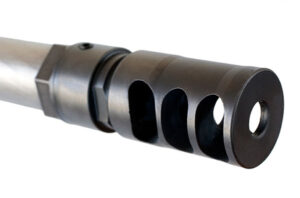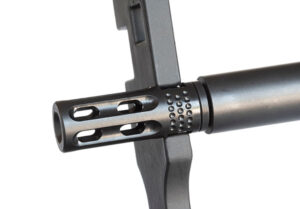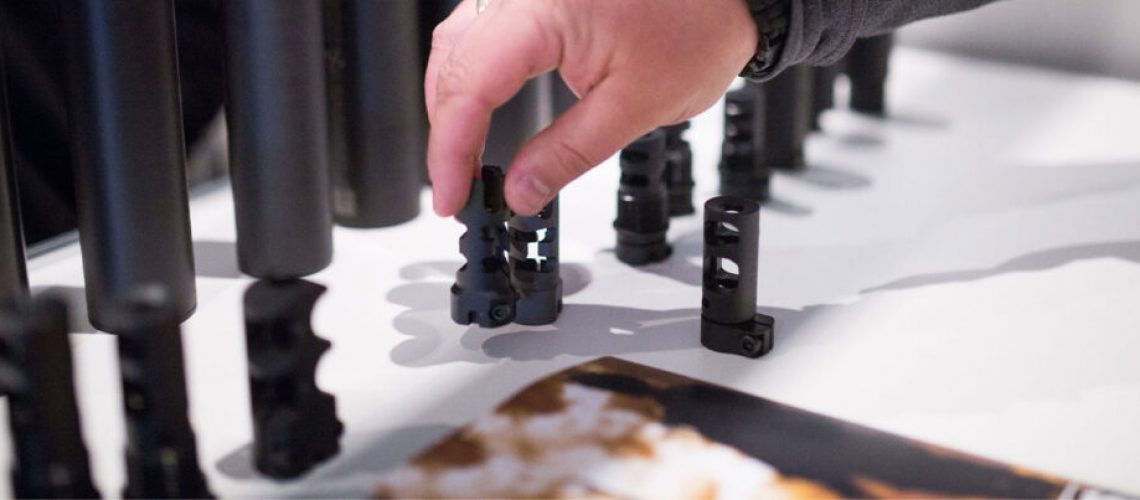Proper muzzle control benefits a shooter in a myriad of ways. It allows for faster and easier re-targeting, as well as aiding in keeping a target in sight.
Accordingly, a number of muzzle devices are employed to help in muzzle control. By changing the shape and behavior of the flame and gas coming from the muzzle, you can change the movement, felt recoil, and even the visual or sound signature of the shot.
 MUZZLE BRAKE
MUZZLE BRAKE
“Muzzle rise” is the tendency of a barrel’s front end to rise after firing. It’s that “jump” of the muzzle caused by recoil, especially noticeable when multiple shots are fired in succession, making it difficult to maintain accuracy.
A muzzle brake is intended to reduce recoil, thereby lessening movement of the muzzle, and the whole gun. The name makes it easy to remember the function—just like in your car, the brake reduces movement.
How does a muzzle brake achieve this? By redirecting propellant gases to counter recoil. Many muzzle brakes have large chambers or vents that send muzzle gasses to the side or even slightly backwards. This reduces the amount of force that is pushing directly back on the shooter. This process can even start “pulling” the muzzle forward to counteract the backwards force of the recoil.
Sitting next to a shooter with a muzzle brake can be a somewhat rough experience. All of the gasses now ejecting to the side means increased muzzle blast, increasing sound pressure, and even lead exposure. If you are shooting with a muzzle brake at the range to enjoy the reduced recoil, be considerate.
 COMPENSATOR
COMPENSATORWhereas a muzzle break first and foremost attempts to reduce total recoil, a compensator attempts to reduce muzzle climb. This happens when the compensator diverts gases and muzzle blast in an upward fashion to keep the muzzle of the firearm from rising during firing.
A bright muzzle flash can reveal a shooter’s position in low-light tactical operations, but the bright flash can also harm a shooter’s natural vision in low light by forcing the eye to re-adjust after the bright flash. A bright muzzle flash is especially bad when using NODs (night observation devices) that can easily “flare out” from the momentary bright light source.
Since solutions that involve reducing the amounting of burning propellant tend to alter the performance of the bullet, employing flash hiders can be an attemptto reduce or eliminate the flash by quickly cooling gases as they exit the barrel. The amount of the gases is the same, but the density and temperature are reduced—thus reducing the intensity of the flash.
Types of flash hiders
Cone—Exactly what it’s described to be. A metal cone that’s perhaps the simplest flash hider of all. Prominent examples were evident on turret-mounted WWII British aircraft machine guns, which were chiefly used at night.
Basket—A step further in development from the simple cone, these have slits or holes cut in them. You can see examples used with the M16.
Duckbill—Upper and lower prongs direct gases to the sides. Several models of early M60 machine guns made use of them. Three prong versions are also common.
Birdcage—Pronged, but with a retaining ring at the end to prevent entanglement with vegetation or straps. Also functions as a compensator on closed bottom port models like those on the M16A2.
Vortex Flash Hider—Developed in 1984, and patented in 1995, four prongs just 6 degrees from center (lending the slightly twisting “vortex), it breaks up a flash from several locations and angles.
Hybrids—there are many combination flash hiders that also function as muzzle rise/recoil compensators.
US Legality—Flash suppressors were part of the Federal Assault Weapons ban (they were seen as a “military features”). The ban expired in 2004, but several states (California, Massachusetts, Maryland, New Jersey) do restrict the use of flash suppressors.

SILENCERS/SUPPRESSORS
Naturally, silencers and suppressors are muzzle devices. And, we could go on about them at length. In fact, we did. Just click HERE to refer to our article on all aspects of them—including how to legally own one. While silencers are best known for reducing sound signature, most also reduce muzzle flash and significantly reduce recoil. While this sounds like the best of all worlds, it comes with a high cost, some purchasing complications, and having to carry around a much larger device on the end of the gun.
There are also silencer attachment systems that attach to a muzzle device, as opposed to being directly threaded into the barrel. An adapter is attached to the muzzle device, allowing for fast, easy attachment of silencers.
Muzzle devices can be a tremendous enhancement to your shooting capabilities. Just remember to evaluate each one for its strengths and be aware of the drawbacks. Which, in many cases, may mean an investment in superior ear protection equipment.

